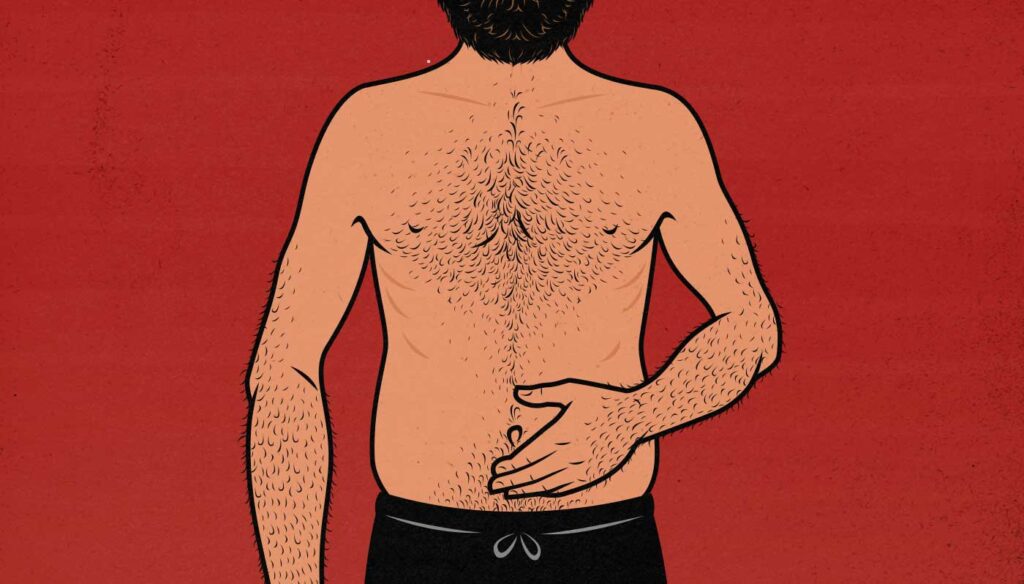
The Guide for Skinny Guys With Belly Fat
Why do some skinny guys have belly fat? If you aren’t overweight, why is fat accumulating, and why is it clustering in your midsection? There are a few reasons this can happen and five things we can do to fix it, but all of it boils down to one term: nutrient partitioning.
In this article, we’ll explain why you’re gaining belly fat instead of muscle when you gain weight and why you’re burning muscle instead of fat when you lose it. If you can fix these two things, you’ll gradually become leaner and more muscular instead of skinnier and fatter.
Then, after covering nutrient partitioning, which will gradually get you in shape, we’ll talk about how to turn up the dial so that you can build muscle and burn belly fat much faster.
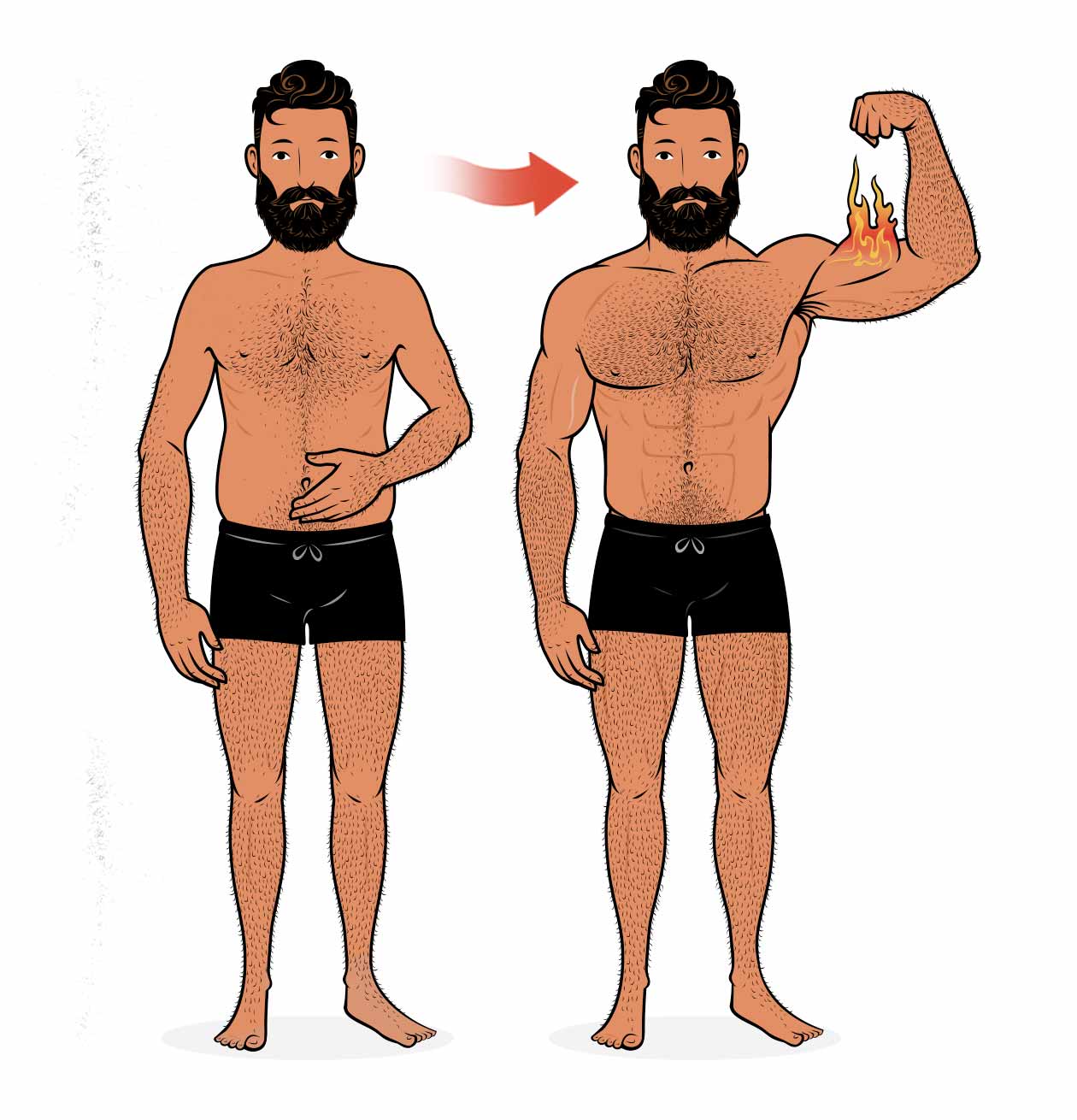
Why Are You Skinny With Belly Fat?
Let’s imagine that you eat 2,500 calories every day. 2,400 of those calories fuel your body and daily activities, leaving 100 extra calories. Where do those extra calories go? Are they burned off, are they invested into muscle growth, or are they stored as fat? And if those extra calories are stored as fat, are they stored specifically as belly fat?
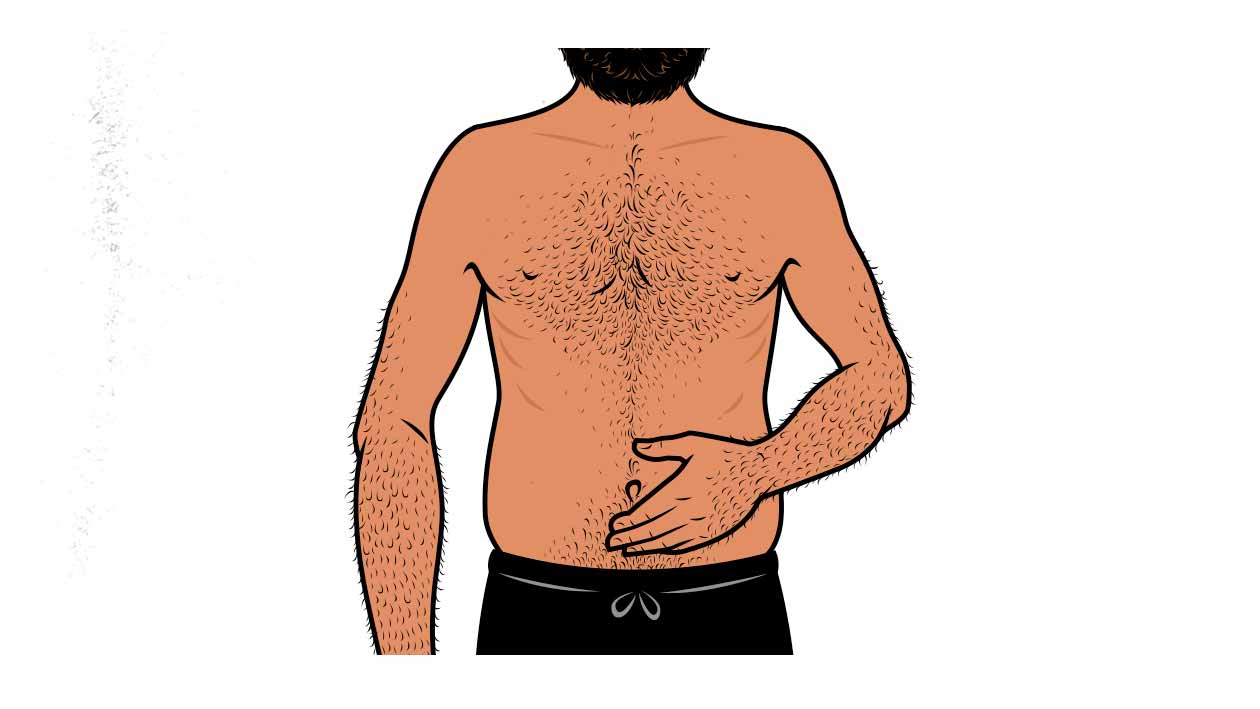
Now let’s imagine that you eat 2,300 calories every day… but you still burn 2,400 calories as fuel, leaving a deficit of 100 calories. Where are those calories taken from? Does your metabolism slow to cancel out the deficit, are the calories taken from your muscle mass, making you skinnier, or are the calories taken from your fat stores, making you leaner? And if those calories are taken from your body fat, are they taken specifically from your belly fat?
If you have good nutrient partitioning, when you gain weight, you’ll gain mostly muscle. When you lose weight, you’ll lose mostly fat. Over time, you’ll either become more muscular, leaner, or both.
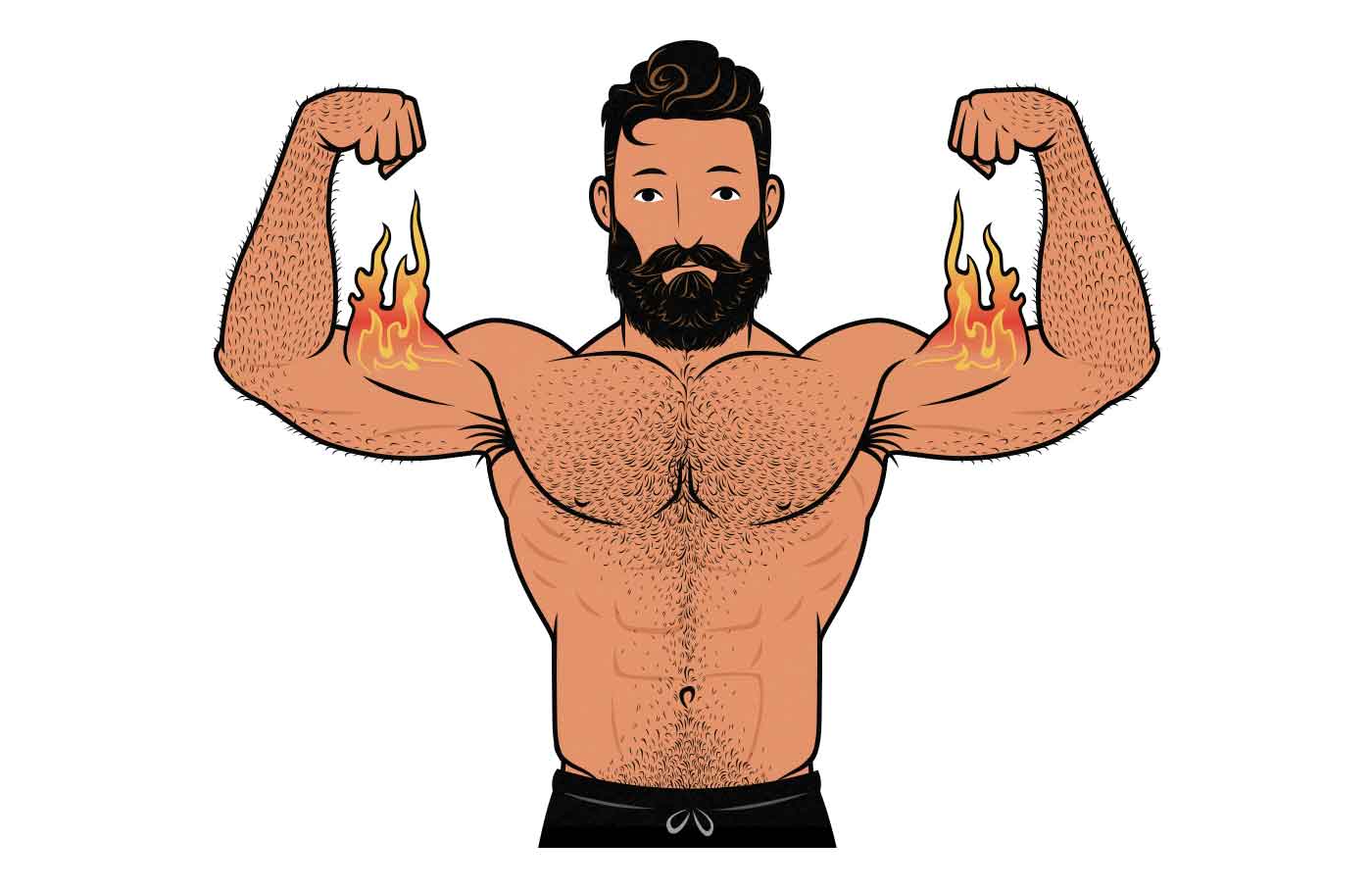
But if you have bad nutrient partitioning, when you gain weight, you’ll gain mostly belly fat. When you lose weight you’ll lose mostly muscle. And over time, you’ll either become skinnier, fatter, or both—skinny fat.
So, how can you improve your nutrient partitioning? How can you make it so that when you lose weight, you lose belly fat? And how can you make it so that when you gain weight, you gain mostly muscle?
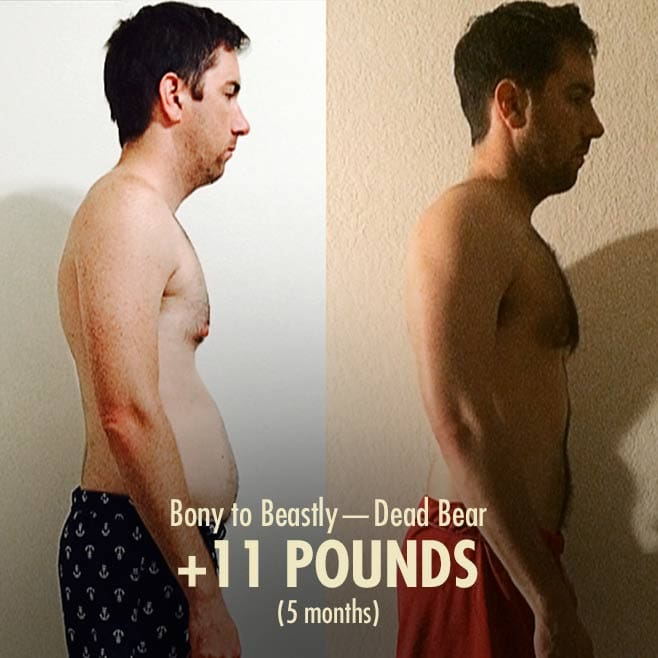
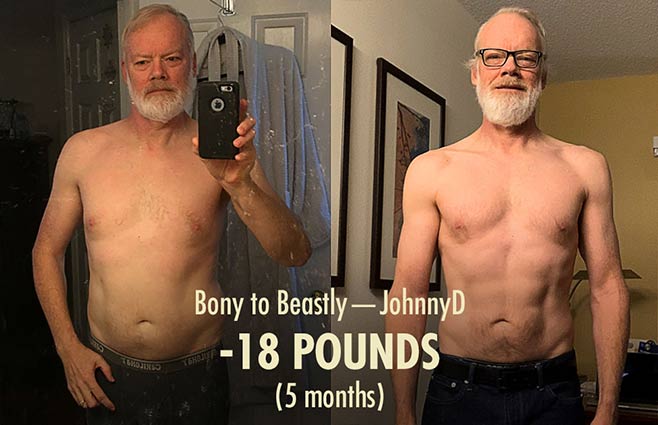
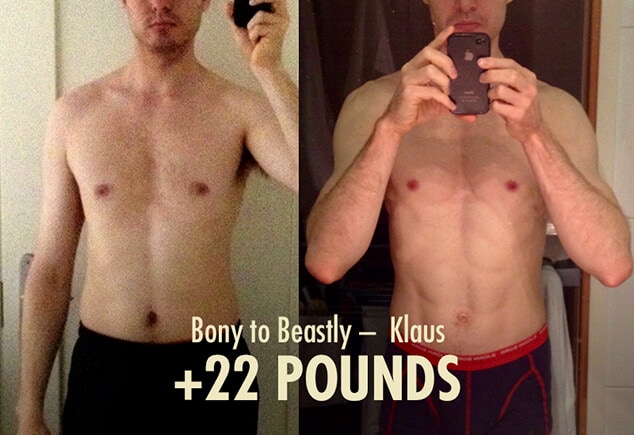
How to Improve Nutrient Partitioning
Resistance Training
Resistance training is by far the most powerful tool for becoming simultaneously leaner and more muscular. If you aren’t in the habit of lifting weights or an alternative, such as bodyweight training or resistance bands, then we’ve found the reason why you’re skinny with belly fat. You’re skinny because your body hasn’t had a need for bigger muscles, and you have belly fat because the extra energy you’ve consumed was stored as fat instead of muscle. The solution, then, is as simple as it is hard: lifting weights.
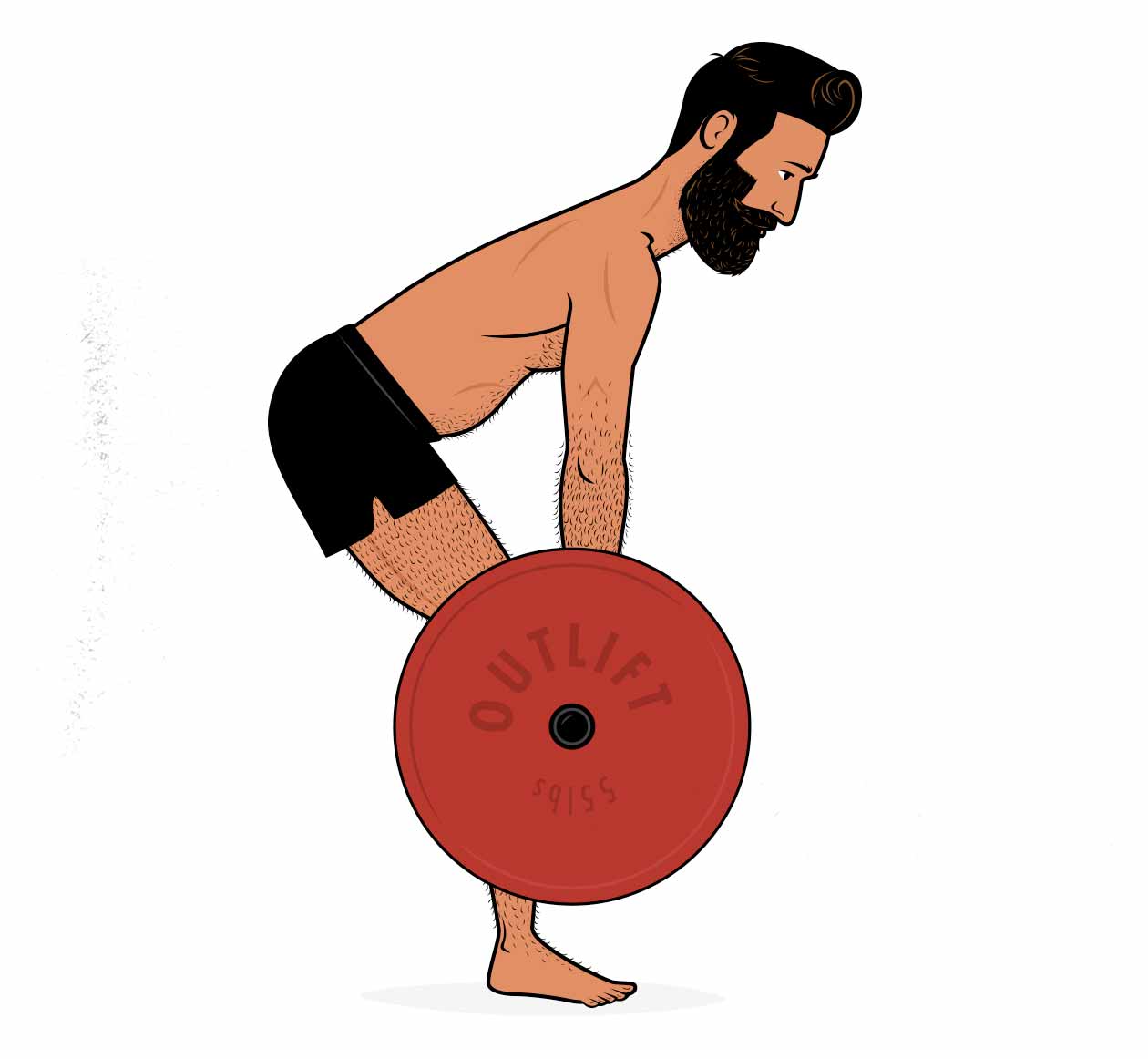
The solution is simple in the sense that you don’t need to overthink it. Hypertrophy training (aka bodybuilding) is best, but most weight training programs will be good enough to stimulate muscle growth. Approach each workout with the goal is lifting more weight or doing more repetitions than last time, and as you progressively outlift yourself, you will gradually build muscle.
The solution is hard in the sense that it’s hard to find the time and energy to overcome the inertia of a sedentary lifestyle. It’s hard to get into the habit of lifting weights, it’s hard to learn a bunch of new lifts, it’s hard to add weight to the bar, and it’s hard to fight for extra reps each workout. If you need to build a home gym or get a gym membership, it might also cost some money that you didn’t plan on spending. But if you have the drive to actually do it, it will work wonders.
For example, in this 12-week study, the researchers split the participants into three groups. The first group wasn’t told to work out, they were just put on a fat-loss diet. Here are their results:
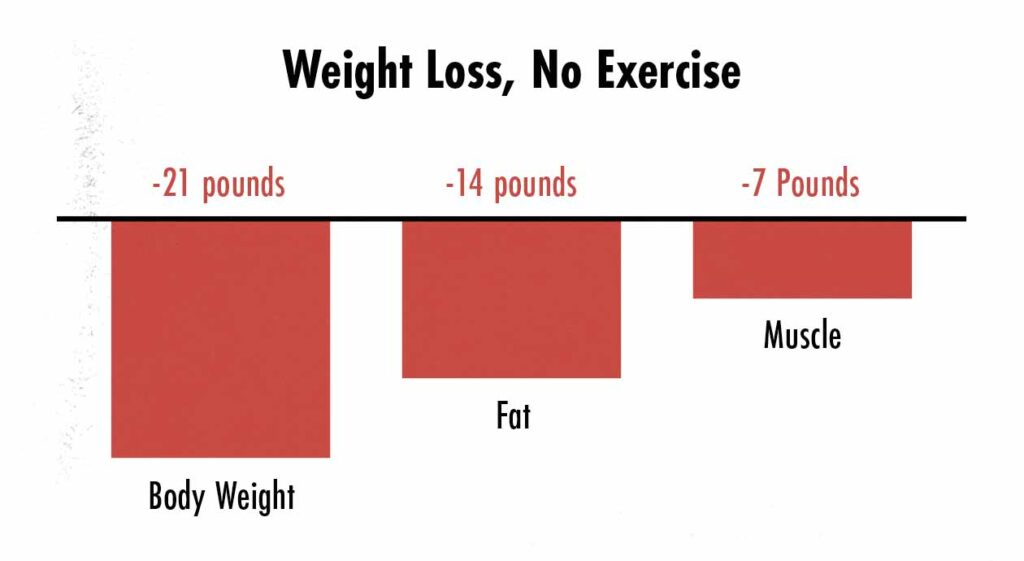
As expected, the calorie deficit did indeed cause them to lose weight, but only 1/3 of the weight loss was muscle. That means they were losing weight with the same 2:1 ratio of fat-to-muscle that people become overweight with in the first place. So by losing weight, they weren’t improving their ratio of fat to muscle, they were just getting smaller. That’s why losing weight doesn’t always help people who are skinny with belly fat.
The second group of participants were given a cardio workout routine in addition to their fat-loss diet. Here are their results:
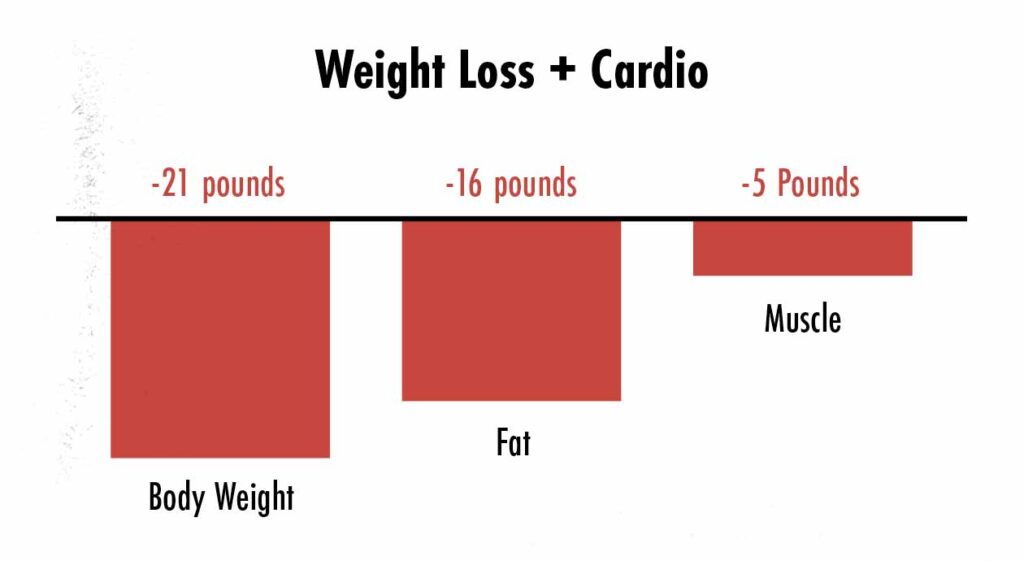
This group lost the same amount of weight, but by adding cardio to their diets, they were able to lose more fat while preserving more muscle. This time, only 1/4 of their weight loss came from muscle mass. That’s slightly than the fat-to-muscle ratio that most people gain weight with, so now they aren’t just getting smaller, they’re also improving their nutrient partitioning, improving their body composition. This is a solution. But it’s not a perfect one.
The third group of participants had resistance training added to their fat-loss plans. Here are their results:
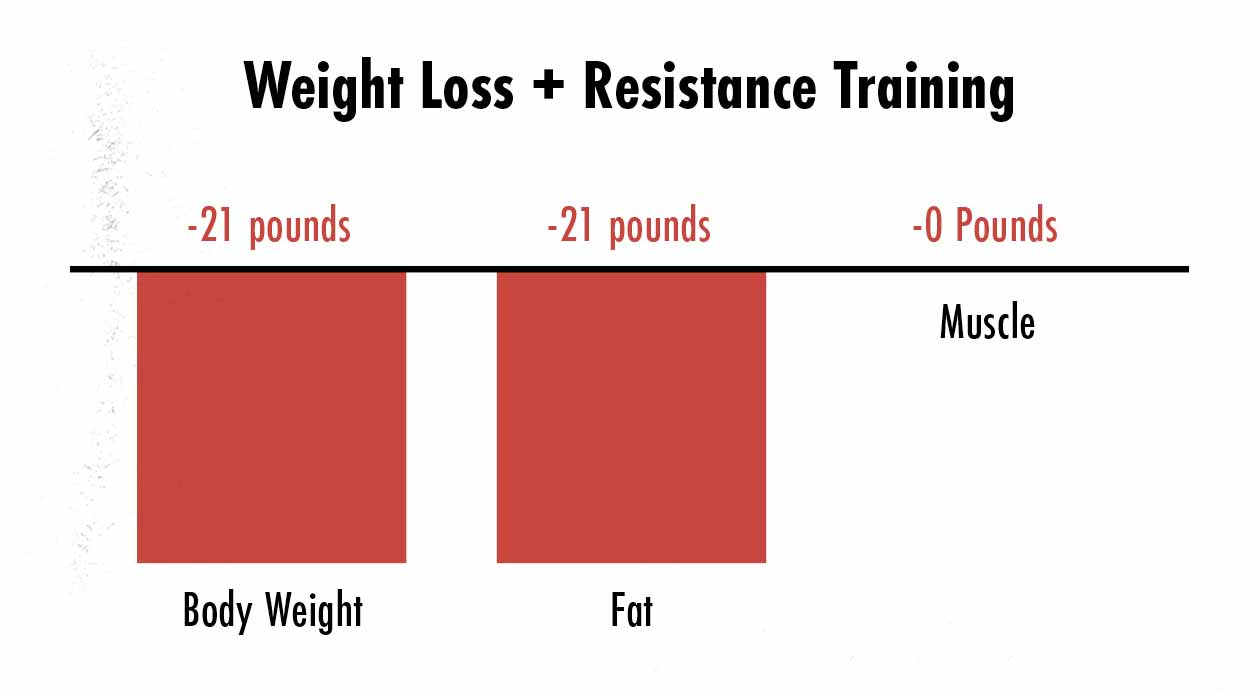
Again, this group lost the same amount of weight, but by adding resistance training to their routines, they were able to preserve all of their muscle mass. 100% of the weight loss came from fat. This is the path out of skinny-fatness. This is how to burn pure belly fat.
In fact, by improving just a few variables, we can probably help you build muscle at the same time as losing fat, as evidenced in a follow-up study:
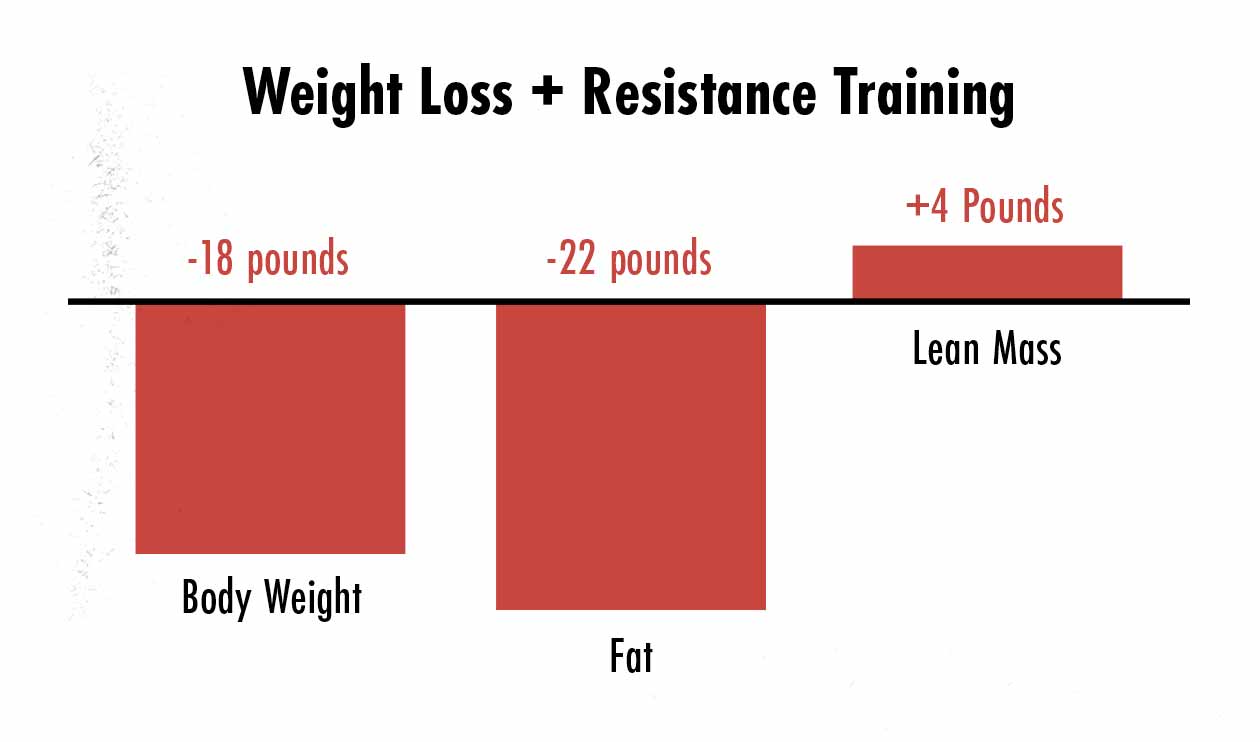
In this second study, we see that the participants who combined a fat-loss diet with weight training were able to lose fat while simultaneously gaining muscle. Because they were losing weight overall, we’d call this cutting, but since they were building muscle at the same time, you could also call this body recomposition.
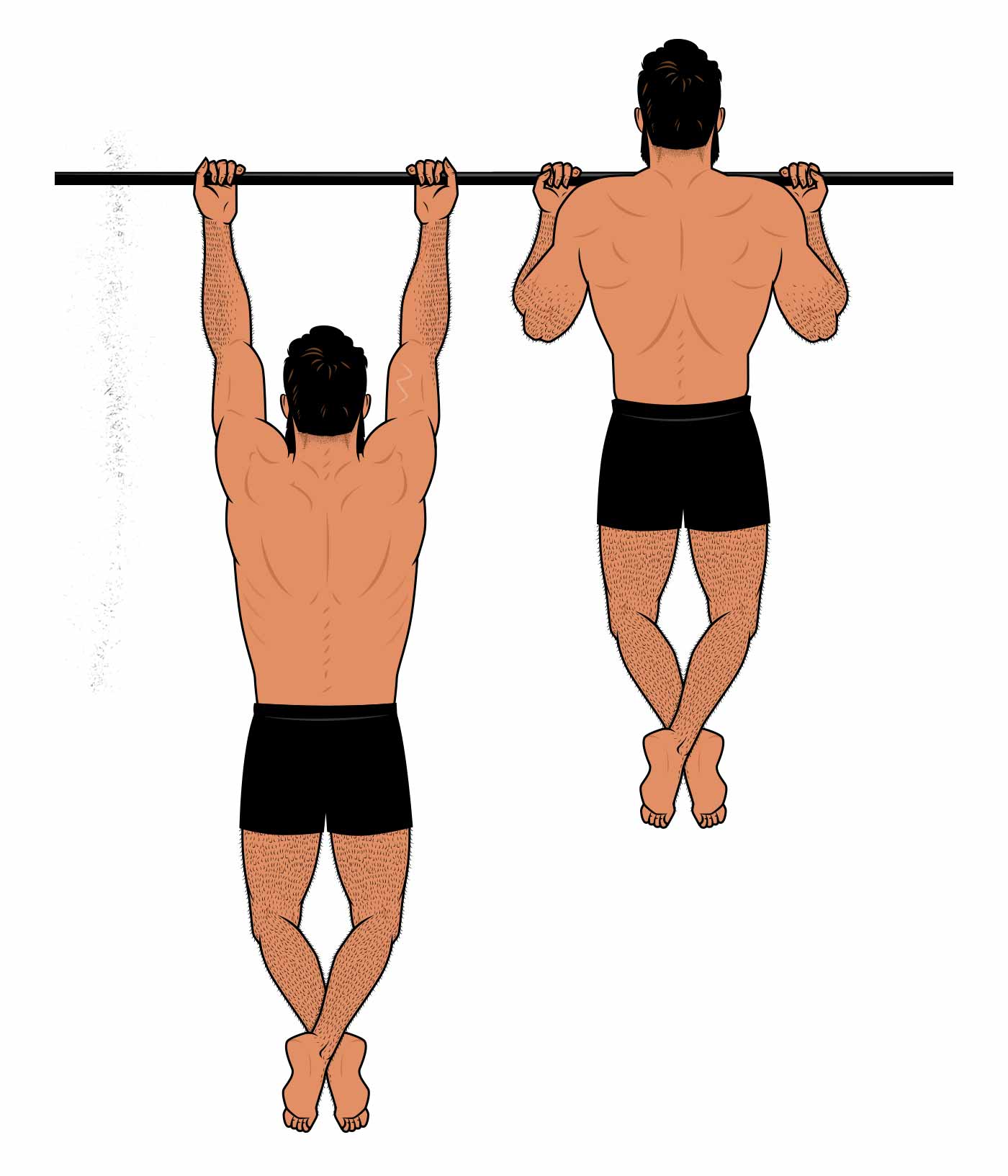
What’s the takeaway from this research? First, cardio is actually quite helpful for skinny-fat guys, and don’t let anyone tell you otherwise. Not only is it good for our general health, but it also helps with nutrient partitioning. But even so, weight training is far, far more important. If you can do both, great—that’s ideal. But if you only have 2–3 hours per week to exercise, better to spend that time lifting weights. It’s by far the fastest way to burn fat while maintaining or even gaining muscle mass.
Now, what’s the best way to get into lifting weights? The first thing to keep in mind that is that different types of resistance training are designed with different goals in mind. Strength training is designed for people who are trying to get stronger for their size, Olympic weightlifting is for people who are trying to develop explosive power, CrossFit is for people trying to improve their general fitness, and hypertrophy training is for people who are trying to build muscle. If your goal is to build muscle, best to do the type of weight training designed specifically for that goal: hypertrophy training.
We have a beginner’s hypertrophy program for men, a beginner’s hypertrophy program for women, and an intermediate hypertrophy program for people who already know how to lift weights. Or, if you want to start with bodyweight training, here’s our free bodyweight workout guide.
Eating Enough Protein
By far the most powerful way to improve your body composition is weight training. If you’re skinny with belly fat, that’s the place to start. But once you’re in the habit of lifting weights, we can further improve your results by ensuring that you’re eating the building blocks that muscle is constructed with: protein.
Now, simply increasing your protein intake won’t do much by itself, just like how tossing a bunch of blocks onto the ground isn’t a great way to build a castle. But if you’re already working out, the nuclei in your muscle fibres are already fighting to build that castle as fast as possible, and so you can help them out a great deal by giving them more building blocks to work with. This gives us a 1, 2 sequence: lift weights then eat enough protein.
If we look at this study, all of the participants were put on a hypertrophy training program and instructed to eat in a calorie deficit. Half of them ate a fairly average amount of protein (about 0.5 grams of protein per pound bodyweight per day) whereas the other half were instructed to eat a gram of protein per pound bodyweight. For a 150-pound man, that’s 75 grams versus 150 grams of protein per day. Here are their results:
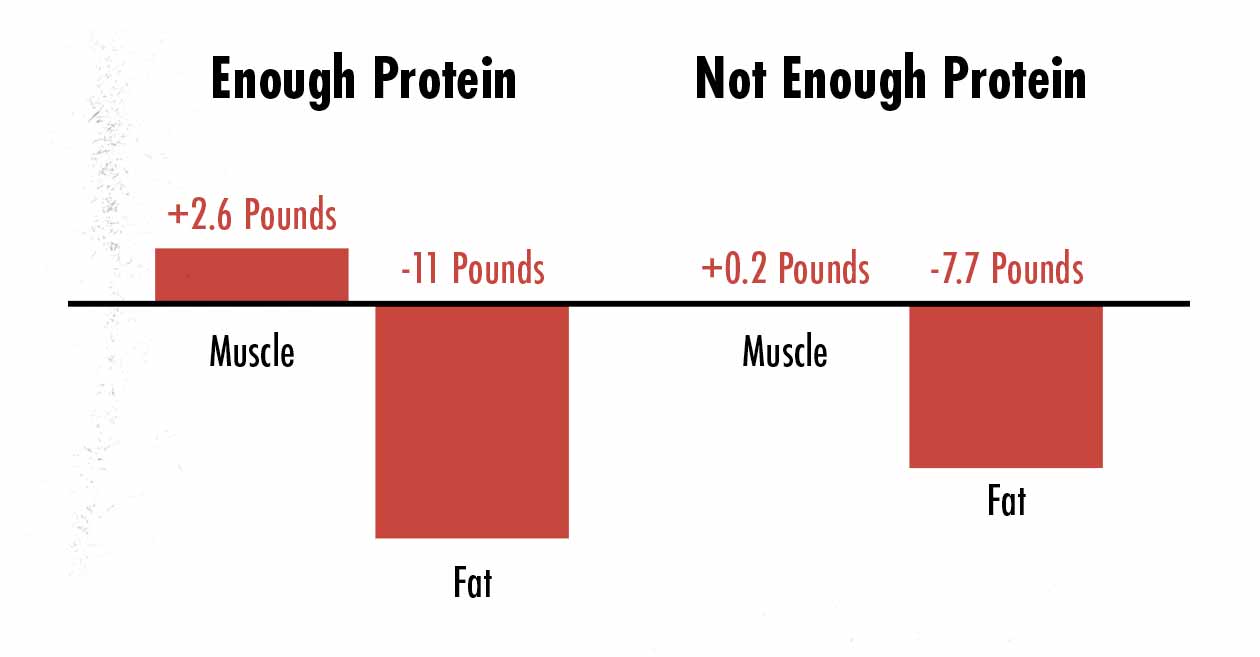
After four weeks, the participants who were eating a standard amount of protein lost 7.7 pounds of fat but failed to gain a statistically significant amount of muscle. That’s a great improvement in body composition, and their results were absolutely worth celebrating… but the group who was eating enough protein lost 11 pounds of fat while gaining 2.6 pounds of muscle. They achieved body recomposition while cutting.
Notice that we’re saying “enough” protein, not “more” protein. There’s a limit to how much protein we need. We need to give the nuclei in our muscle fibres the building materials that they need, but beyond that, any extra protein we eat will be used as energy, just like fats and carbs. There’s nothing wrong with eating extra protein, but there’s no advantage to it either. About a gram of protein per pound bodyweight per day is enough. More than that is fine but won’t yield additional benefits.
The takeaway here is that lifting weights is the most important part of burning fat while maintaining your muscle, and it’s often enough to cancel out muscle loss while cutting. But we can get even better results by eating enough protein: 1 gram of protein per pound bodyweight per day.
Getting Enough Sleep
After you’re in the habit of lifting weights and eating enough protein, the next most important intervention is improving your sleep. Now, keep in mind that there’s a sequence to this plan. If you aren’t lifting weights, improving your sleep might improve your energy, hormones, mood, and general health, but it won’t do very much to improve your body composition. In fact, plenty of get-it-done personality types get great results by waking up early to squeeze in their workouts. But we can do better than that.
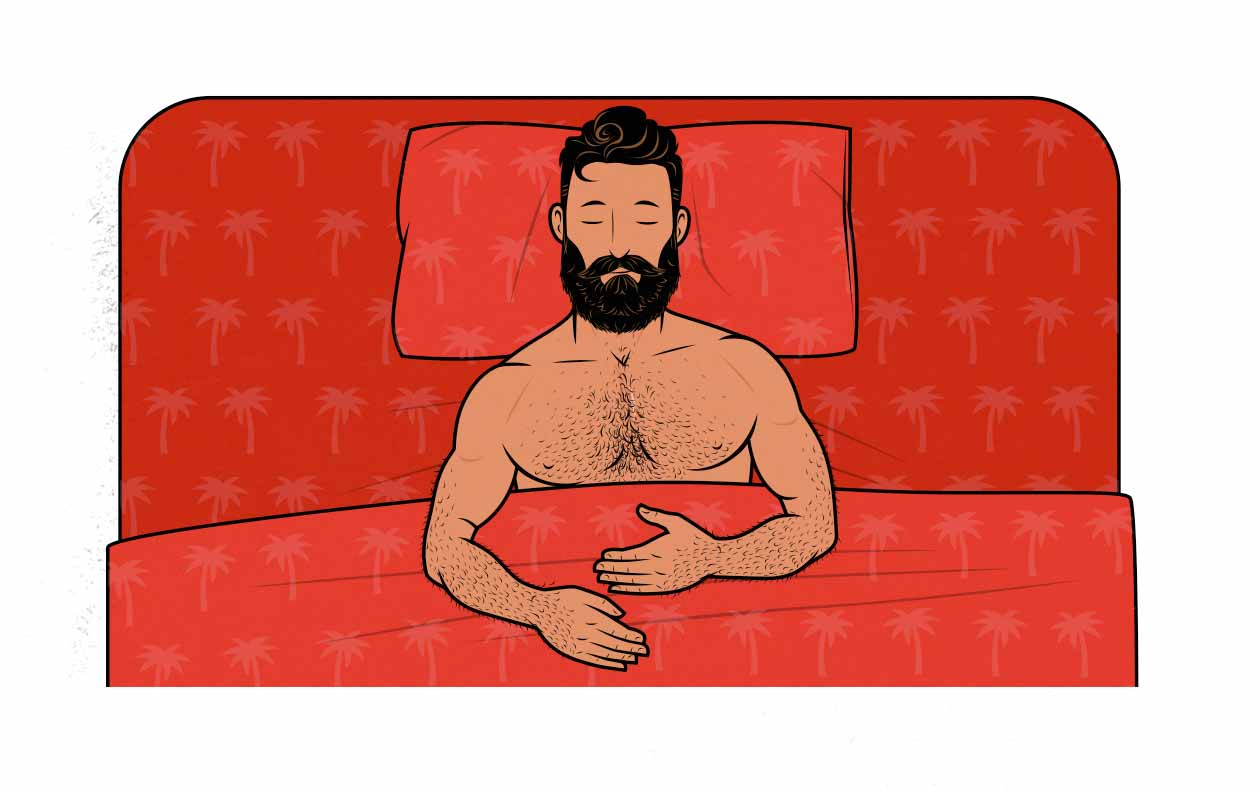
A recent study investigated the effect of sleep on muscle growth and fat gain when combined with a weight training program. Half of the participants were given just the weight training program, whereas the other half were also given advice about how to improve their sleep. Here are their results:
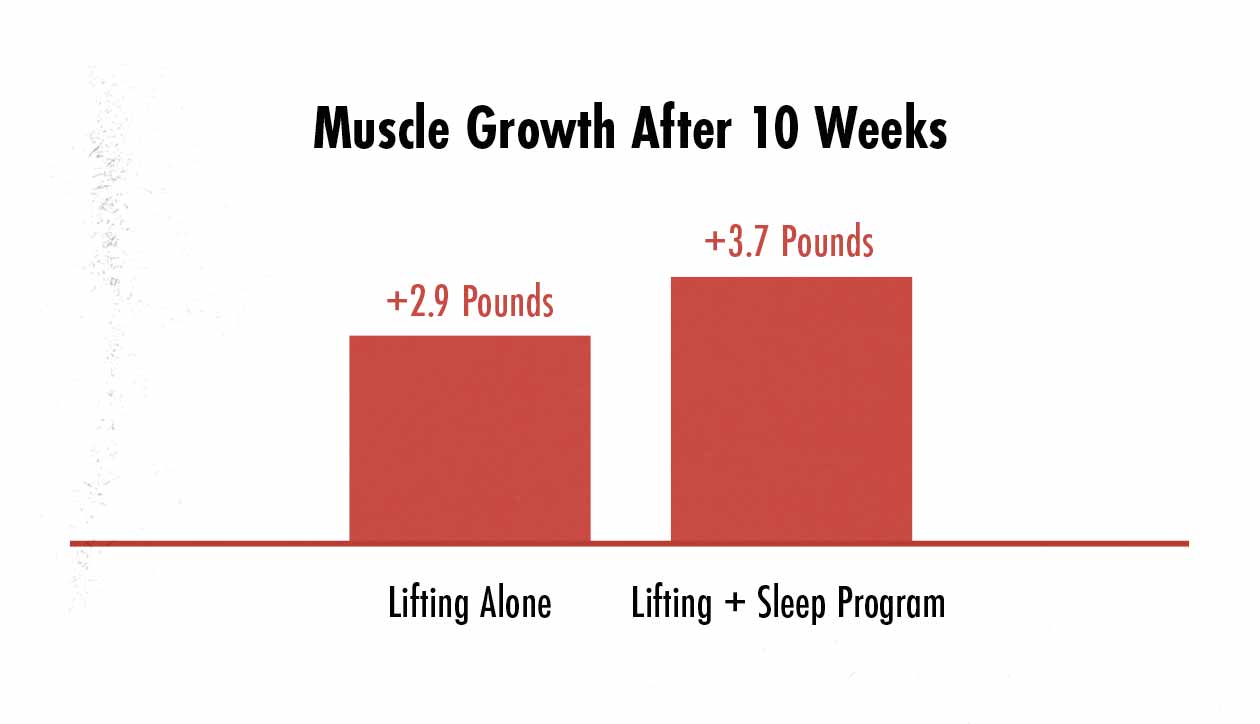
The results of this study show that simply by learning some tips about how to improve our sleep, we can increase our rate of muscle growth by 30%. It gets better, too. Look at what happened to their fat gains:
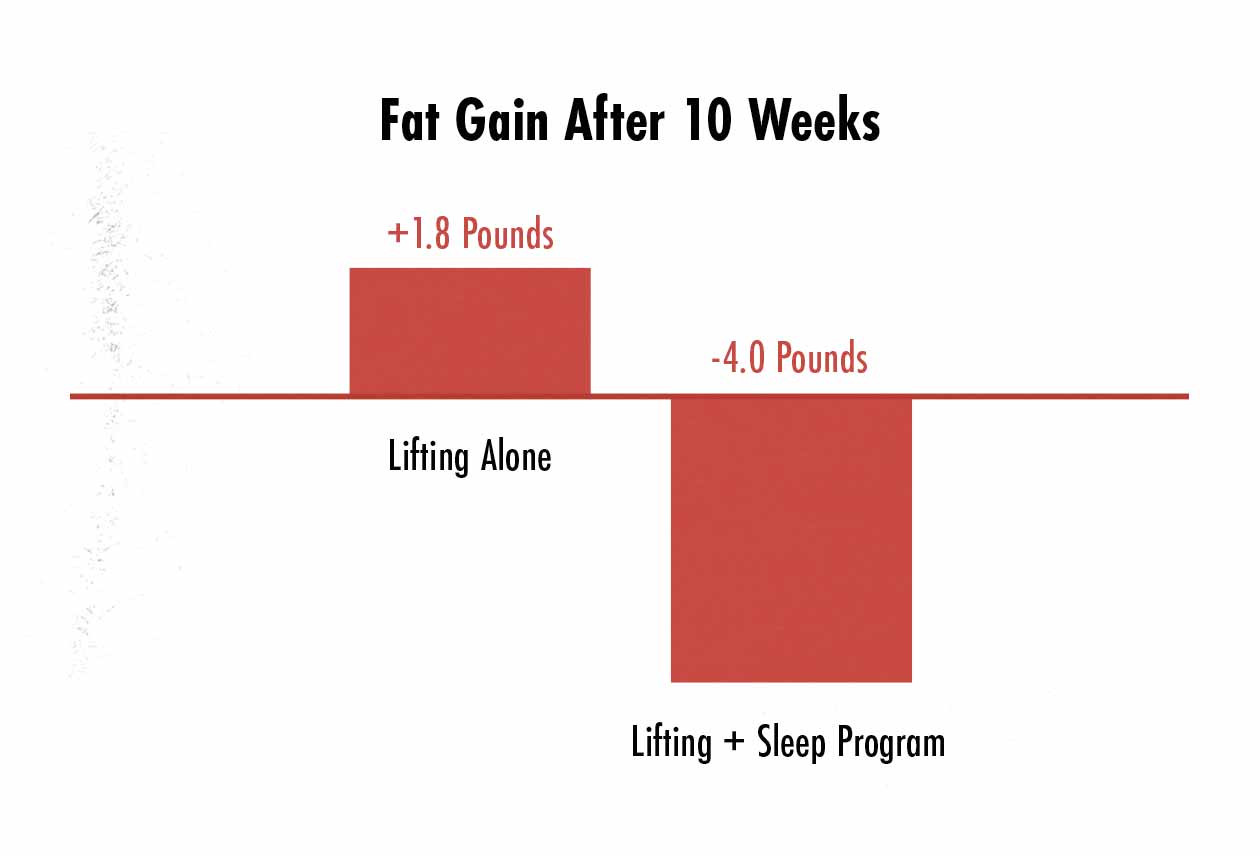
So what we’re seeing is that group who lifted weights gained more muscle than fat, but they still gained a bit of fat. They improved their body composition, and these are great results, but the group who improved their sleep did much, much better. Not only did they build 30% more muscle, they also lost fat at the same time—body recomposition.
Previous research found this same nutrient partitioning effect. And a third study found a possible mechanism for this: getting enough good sleep increases our muscle-protein synthesis. Plus, in addition to helping us build muscle more quickly and leanly, getting better sleep can also improve our workout performance (study, study) and lower our overall inflammation (study). Overall, this research shows that sleep is a powerful tool for improving nutrient partitioning—for shuttling the food we’re eating towards muscle growth instead of fat gain.
Perhaps most interestingly of all, the study participants weren’t put in a sleep lab or anything fancy. They were simply given tips to help them improve their sleep. These are results that you can get at home, from the comfort of your very own bed.
So, how do we improve our sleep? It ultimately boils down to two things:
- Get enough sleep: 7–8 hours is enough for most people, and I recommend experimenting with the higher end. If you find yourself routinely waking up an hour early feeling refreshed, then that’s a sign you may need less sleep.
- Get better quality sleep: ideally you want to fall asleep easily and then get a restful sleep without waking up too many times during the night. The most important factor is reducing your stress before bed, which can be done by relaxing away from screens, work, and notifications. For example, going into your study or bedroom an hour before bedtime to read a speculative fiction novel by dim lamplight.
There are quite a few strategies for improving your sleep, though, and we cover all of them in our free guide on improving sleep for muscle growth.
Being Generally Healthy
The big three interventions for building muscle while burning belly fat are weight training, eating enough protein, and getting enough good sleep… but there are a bunch of other smaller factors. You don’t need to worry about them right away, but they’re good to keep in mind, especially if you’re looking for an edge. Plus, all of these interventions improve our body composition by making us healthier, which is perhaps the most important thing of all.
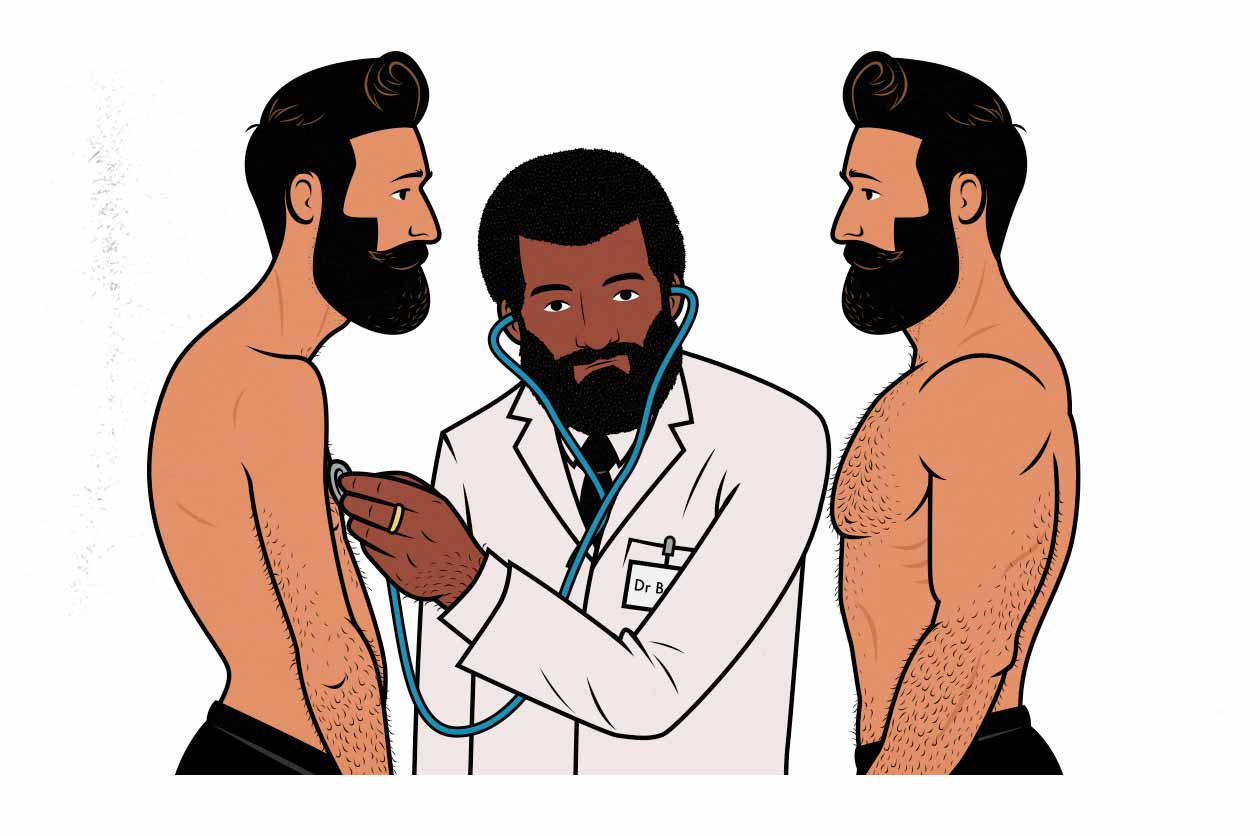
So, there are a few important parts of living a healthy lifestyle. There are millions of small details, but painting with broad strokes here, we can paint a rough picture:
- Eat mostly whole foods—around 80%. Whole foods are hard to define, but you know them when you see them. Fish, chicken, eggs, cheese, yoghurt, oats, fruits, nuts, legumes, veggies, and olive oil, are all fairly clear examples of whole foods. But what about milk, whey protein, rice, tortillas, and whole-grain bread? Those foods are all at least somewhat processed, but they aren’t exactly junk food either, right? Right. If you want to count those as whole foods, no problem—close enough. Or if you think white rice is the insulin devil, no problem—don’t eat it. We don’t need to sweat these small details.
- Spend some time walking outside every day, even when it’s raining or snowing or you’re feeling lazy. Some people do this by walking to class, walking to work, or walking their dog. But the important thing is to make walking outside a regular part of your lifestyle. Not only will that give you some sunshine, improving your vitamin D production, it will also help to keep you fit.
- Keep your alcohol consumption under control. Most research shows that women are fine with one drink per day, men with two. Is it even better to drink even less? Maybe. Again, it’s hard to say because it doesn’t seem to matter very much. As long as you aren’t overdoing it, it seems fine to have a drink or two most nights. It won’t noticeably impact belly fat or muscle growth (study). It’s only when drinking starts to get out of hand that it starts to cause problems.
- Manage stress. There’s nothing wrong with being stressed now and then. But try to set aside some time for relaxation, too, so that the stress doesn’t become chronic and overbearing. Obviously, this is easier said than done, but even small interventions like setting aside an hour before bed to read a relaxing novel can help to separate stress from sleeping, giving you a needed break. Fortunately, exercise and improving your sleep both seem to help with mood and stress, so in the process of improving your body composition, you may notice that your stress levels naturally start to ease.
We have a free guide on how to bulk the healthy way, but even just loosely following these tips can go a long way. If you’re in the habit of working out, eating enough protein, eating mostly whole foods, getting enough sleep, spending some time walking outside, and you aren’t crippled by stress, most research shows that you’re doing the most important things for your general health.
Energy Balance
If you’re a skinny-fat beginner who’s new to all of this, you don’t need to think about your energy balance right away. As with the rest of these interventions, there’s a sequence to this. If you start by manipulating your energy balance, you run the risk of losing muscle while losing weight or gaining fat while gaining weight. Energy balance is an important factor, but it relies on understanding nutrient partitioning. We need to make sure that when we lose weight, we’re burning fat, and maybe gaining a bit of muscle. We need to ensure that when we gain weight, we’re gaining mostly muscle, and maybe even losing a little bit of fat.
But once you’ve gotten into the habit of weight training, eating enough protein, getting enough sleep, and leading a generally healthy lifestyle, your nutrient partitioning will be good, and so it’s time to starting speeding things up by manipulating your calorie intake.
- If you want to burn belly fat faster: start eating fewer calories, losing weight, cutting.
- If you want to gain more muscle size and strength: start eating more calories, gaining weight, bulking.
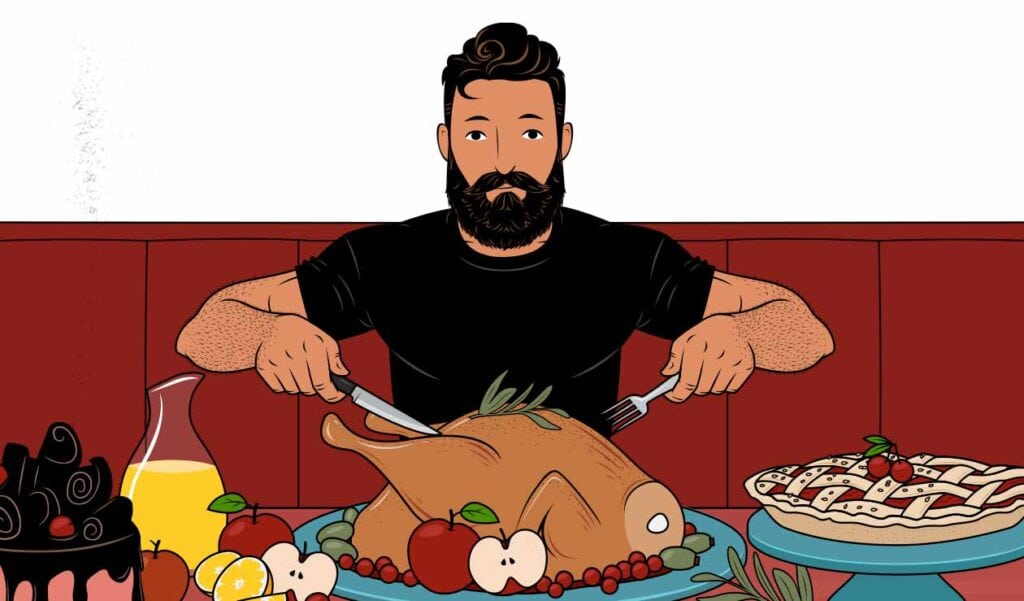
Now, we’re not saying that you should eat a starvation diet, nor are we saying that you should bulk so aggressively that you gain a ton of fat. No, we’re saying you should think about steadily losing weight with a modest calorie deficit of around 500 calories per day. We’re saying you should think about slowly bulking up with a calorie surplus of around 250 calories per day.
Counting calories can be helpful, but you don’t need to. If that’s too much hassle, weigh yourself every week, and think about “eating a bit more” or “eating a bit less.”
- If you’re struggling to gain weight, think about adding in a smoothie, adding snacks between meals, having a glass of milk with meals, or adding some extra starchy carbs to your meals (more rice, pasta, beans, bread, etc). We’ve got a free guide on eating more calories here.
- If you’re struggling to lose weight, think about cutting back on liquid calories, cutting back on snacks, eating more protein, eating more berries, eating more fibre, eating less junk food, and avoiding eating out of boredom while lounging—while watching TV and whatnot.
None of these are perfect solutions. When you’re slowly gaining weight, you may find yourself feeling perpetually full. When you’re losing weight, you may find yourself dealing with hunger pangs and cravings. These things should be expected. They aren’t a sign that you’re doing anything wrong. Just keep weighing yourself every week and adjusting your calorie intake accordingly.
For more, here’s our bulking and cutting guide for skinny-fat guys.
The Big Five Approach to Skinny-Fatness
Alright, so we’ve gone over five main interventions that will help you to burn belly fat while building muscle, allowing you to steadily climb your way out of skinny-fat hell:
- Lift weights to stimulate muscle growth.
- Eat protein to build the muscle with.
- Get enough good sleep.
- Try to lead a generally healthy lifestyle.
- Eat the right amount of food.
We’ll call these the Big Five. There are a myriad of other ways to improve body composition, but most of them slot themselves into those four main categories, and often in a minor way.
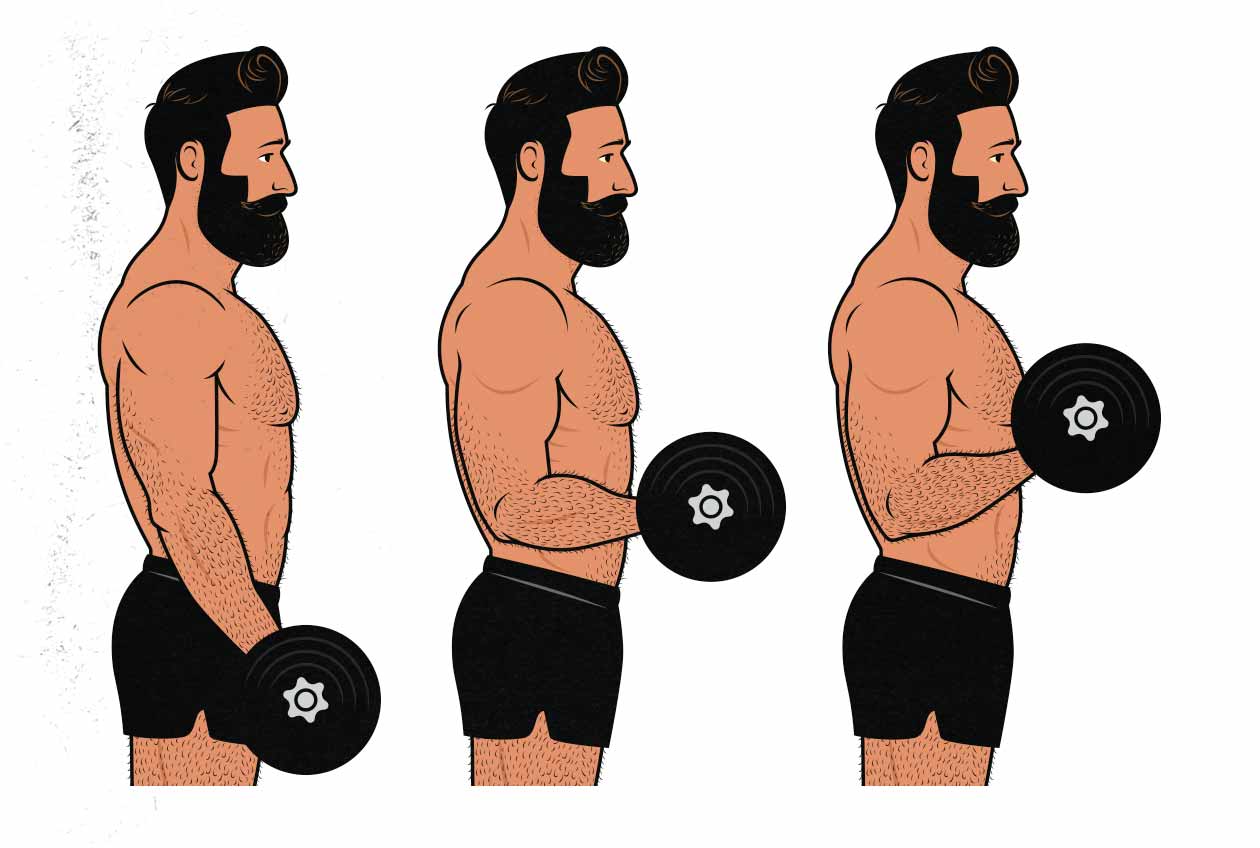
If you hear that doing sets of 6–15 reps builds more muscle than doing sets of 3–5 reps, or that reverse pyramid training (RPT) is a good way to train, or that we should focus on compound lifts, that we should add isolation lifts to our routines, or that we should push ourselves close to failure—that can all be true, and it slots into intervention #1: weight training. But these are just details. The most important thing is weight training.
For example, if you hear that supplementing with BCAAs or whey protein, or eating more meat, or focusing on higher-protein foods will help your body composition, that’s true, and it slots into intervention #2: eat enough protein. If you’re eating enough protein, these details stop mattering very much.
You could optimize your carb and fat macros. That can help, a little bit (more on that here). But if you’re already eating a generally healthy diet made up of mostly whole foods, it probably won’t matter enough to be noticeable. When it comes to plant-based diets, ketogenic diets, and intermittent fasting, all of those approaches can work, but don’t expect to get better results from them. In fact, most of them tend to make it at least slightly harder (or at least more complicated) to build muscle.
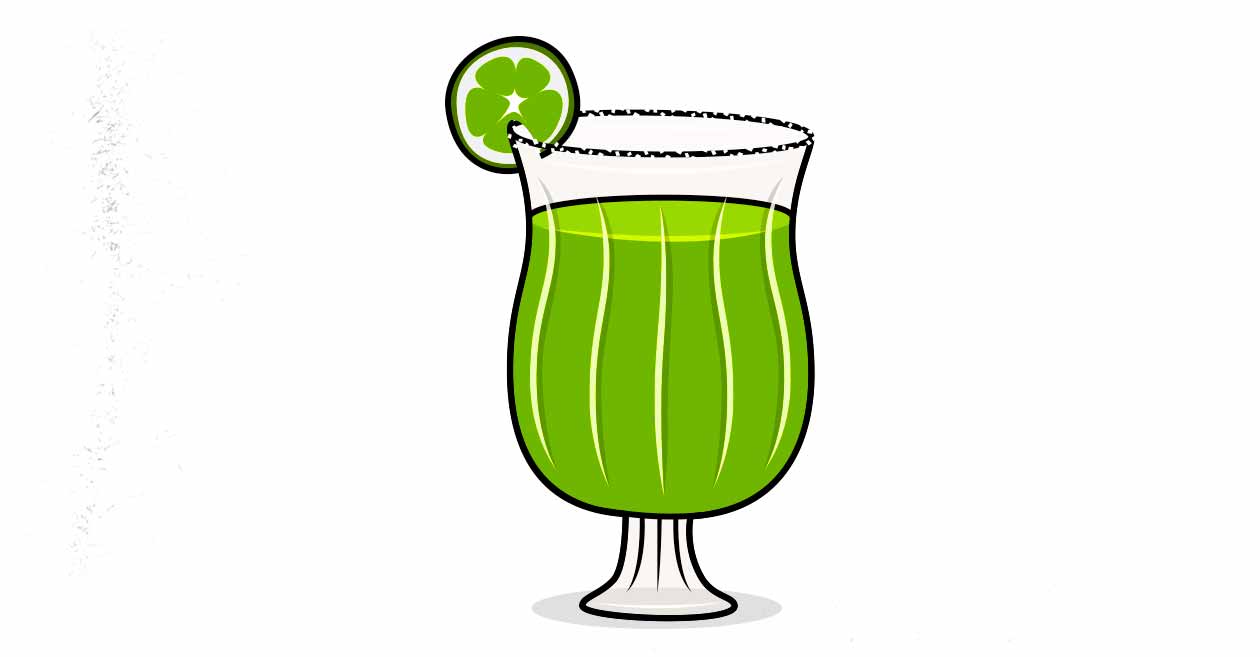
There’s nothing wrong with experimenting with supplements (such as creatine), neat training ideas (such as neck training), or interesting dietary approaches (such as intermittent fasting), but they aren’t powerful enough to rely on. If you aren’t happy with your results, don’t turn to weaker solutions, turn to stronger ones. Turn to the Big Five. And if the Big Five aren’t working, refine them. If your lifting program isn’t allowing you to add weight to the bar every couple weeks, think about improving your training program, eating more protein, eating more calories, getting better sleep, or, as a last resort, restricting yourself to just two margaritas per day.
What About Body Recomposition?
Body recomposition is viable… sometimes. If you’re still new to all of this, it’s okay to start with weight training, increasing your protein intake, improving your sleep, and trying to lead a healthier lifestyle. That will often be enough to simultaneously build muscle and burn belly fat, especially if you fall into one of the following categories:
- New lifters: skinny-fat guys who are new to weight training will be able to make newbie gains even if they don’t gain weight overall. This is because their muscles are still so sensitive to muscle growth, still extremely far away from their genetic potential.
- Detrained lifters: if you were muscular in the past but you’ve let yourself get out of shape, then you’ll be able to take advantage of muscle memory, regaining your lost muscle without needing to be in a calorie surplus. (This includes guys who are still in the habit of lifting, but who aren’t as big or strong as they used to be.)
- Overweight guys: if you have quite a lot of extra body fat, you might be able to burn fat while building muscle.
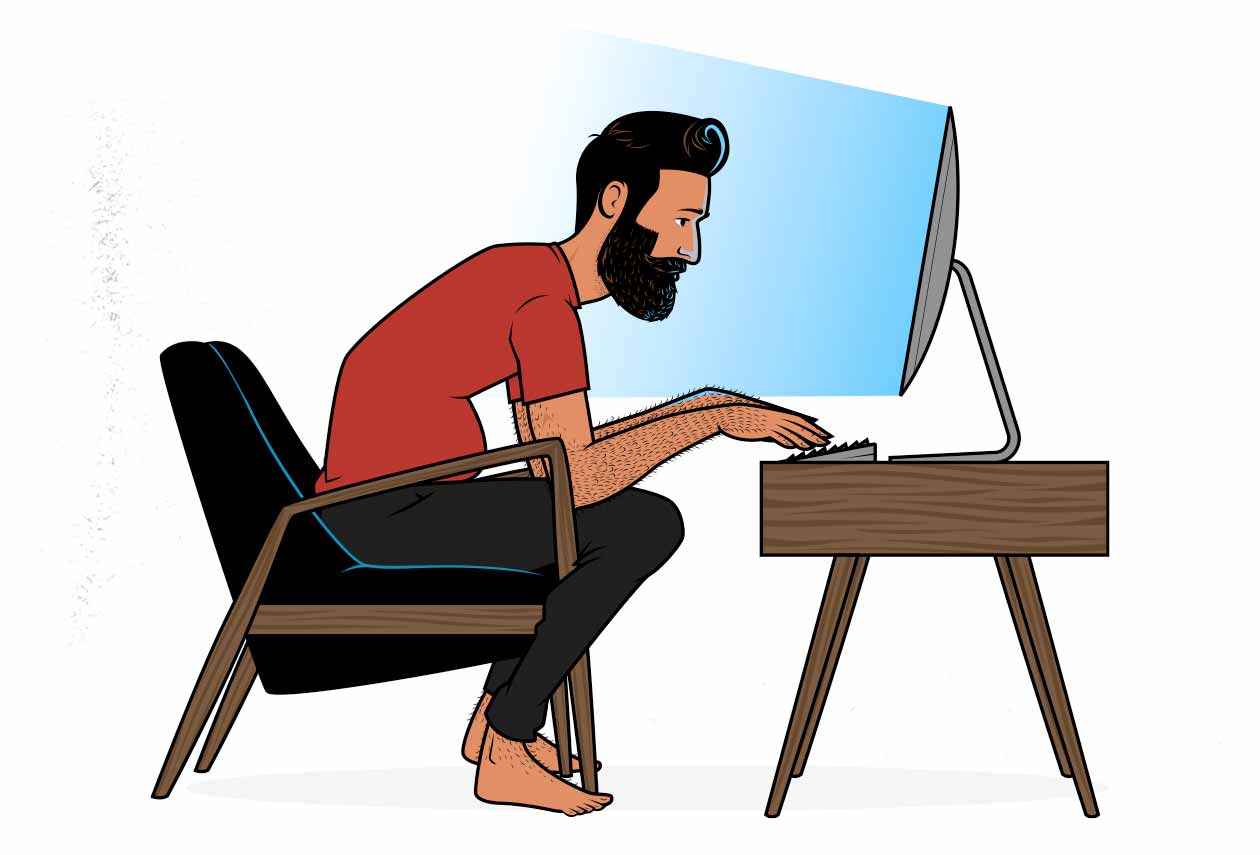
In these situations, body recomposition can make sense. Instead of focusing on calories, you can focus instead on weight training, adding weight to the bar, fighting for more reps, eating enough protein, improving your sleep, and leading a healthier lifestyle. As you do those things, you may find that you gain muscle while losing fat, even if your body weight stays about the same.
However, in all of these cases, you’d be able to build muscle while losing weight, too. You can achieve body recomposition while doing a modest cut. And if you do that, you can burn fat much, much faster. Plus, there are also situations where body recomposition is contraindicated. Let’s imagine some examples:
- You’ve been following a lifting program for a few months, you’ve hit a strength plateau, and you aren’t happy with how your body is looking. You’re feeling a bit chunky and your muscles aren’t as big as you’d like them to be. In this case, you’ve probably gotten your newbie gains, and you’re also finding it hard to build muscle and burn fat simultaneously, meaning you need an easier, more powerful solution.
- You’ve got a bit of belly fat but you’re also skinny and technically underweight. Since you’re technically overweight, it might be hard to burn fat without actually losing weight. And since you don’t have much extra body weight to work with, it might be hard to build muscle without gaining weight.
- You’re an intermediate lifter who’s over-bulked and lost his muscle definition. In this case, you’ve already made your newbie gains, your muscles are in peak condition, and it’s going to be very hard to continue building muscle without gaining weight. Since you can’t build muscle without gaining weight, that also means that the only way to lose fat is to lose weight.
- It’s not working and you need something more powerful. If you’re experimenting with body recomposition and it’s not working—you’re not burning your belly fat, getting stronger, or gaining muscle size—then you need a more powerful approach. It’s time to manipulate your calorie intake.
So there are situations where it makes sense to bulk to gain muscle and to cut to burn belly fat. When doing that, solve the bigger problem first.
- If you’re underweight, start slowly gaining weight to build more muscle.
- If you’re overweight, start slowly losing weight while fighting for muscle growth.
- If your belly fat is stressing you out, start with a cut, but fight to gain strength while you do it.
- If you’re worried that your arms are too small, start with a modest bulk, gaining weight slowly to keep any fat gain minimal.
Overall, body recomposition is a good idea if you’re new to lifting, newly getting back into lifting, or you’re still trying to develop a good lifestyle. But if you’re starting to get frustrated by a lack of progress, it’s time to turn the energy balance dial, either cutting or slowly bulking.
Why’s All Your Fat in Your Belly?
There are a few reasons why people have disproportional amounts of belly fat. The most obvious reason is that men store most of their fat in their midsections, and so when men become overweight, they tend to get bigger bellies. It’s not necessarily any great mystery, it might just be that you have a classic male body-fat distribution pattern and you’ve gained too much fat.
That doesn’t explain why you’re skinny except for your belly. But that doesn’t necessarily have anything to do with fat, it might just be that you haven’t built much muscle yet. When we gain muscle, most of it is in our legs, arms, and around our shoulder girdle—our upper backs, shoulders, and chest. So as we gain muscle, we get bigger everywhere but our stomachs. That means that if we’re skinny with belly fat, it tends to mean that we have too much fat and too little muscle overall. It’s not that we’re storing fat oddly, it’s just that we’re out of shape.

As I gained 60 pounds, I gained thirteen inches around my shoulders and only around two inches around my waist. That’s because most of the weight I gained was muscle, and so most of my measurement increases were in my shoulders, arms, and legs. It didn’t require doing anything special, and there were no real shortcuts, I just had to build a whole bunch of muscle by lifting weights, eating enough protein, improving my diet, improving my sleep, and gaining weight overall.
However, there’s a more insidious reason that some men have thicker midsections: visceral fat. Visceral fat is the unhealthy type of fat that accumulates around our organs, and in sufficient quantities, it can cause all kinds of health problems. We gain a disproportional amount of it when we eat poor diets, eat too many calories, and fail to get enough exercise. The good news is that the solution is fairly straightforward: work out, eat enough protein, improve your sleep, lead a generally healthy lifestyle, and lose fat overall. There’s no magic secret, we just need to get in better shape.
Can Supplements Help Skinny-Fat Guys?
There are a few supplements that can help people build muscle while losing fat. They aren’t nearly as important as lifting weights, eating enough protein, and getting enough sleep, but they can still help.
- Protein powders make it easier to eat more protein. Eating enough protein supports both muscle growth and fat loss.
- Creatine improves workout performance and increases our rate of muscle growth by around 33% (research breakdown). When more calories are being shuttled towards muscle growth, that leaves fewer to be stored as fat, helping with fat loss.
- Caffeine gives us more energy and makes exercising less painful. This can help us be more active and push ourselves harder, helping us build muscle and burn fat.
- Melatonin improves sleep. However, your body can produce it naturally. If you have a good sleep routine, you shouldn’t need it.
For more, we have a full article on supplements that help with body recomposition.
Summary
If you’re a skinny guy with belly fat, your main problem is nutrient partitioning—you’re storing fat instead of building muscle when you gain weight, and you’re losing muscle instead of burning fat when you lose weight. Over time, that can make people skinny-fat.
There are five key ways to fix skinny-fatness:
- Lift weights to stimulate muscle growth. Hypertrophy training (aka bodybuilding) is best, but any type of weight training will do. Even bodyweight training or resistance bands can work in a pinch. Nothing improves nutrient partitioning by nearly as much as lifting weights, making this the obvious place to start.
- Eat enough protein to build muscle at full speed. Muscle growth is stimulated by your workouts, at which point you need to make sure you’re eating enough protein to build that muscle out of.
- Get enough good sleep. By improving your sleep, you can improve your workout performance, anabolic hormone production, rate of muscle growth, and rate of fat loss. It also helps dramatically with nutrient partitioning.
- Try to lead a generally healthy lifestyle. There are a million ways to improve your health, and most of them will have at least a minor impact on your body composition. By leading a lifestyle that’s healthy overall, you can combine many of these minor factors to the point where the can produce a noticeable impact. Start by focusing on exercising regularly, going on a daily walk outside, eating a diet made up mostly of whole foods, managing chronic stress, and keeping your alcohol consumption under control.
- Eat the right amount of food. Once you’re in the midst of doing the four interventions above, the best way to improve your results is to manipulate your weight. Eating more calories and slowly gaining weight (bulking) will dramatically improve your rate of muscle growth. Eating fewer calories and losing weight (cutting) will radically improve your ability to burn fat.
These are by far the most powerful methods for incinerating skinny-fatness. Improve your workout program, double-check your protein intake, make sure you’re eating real food, get to bed on time, and adjust your calorie intake as needed.

Alright, that’s it for now. If you want to know the ins and outs of bulking up, we have a free newsletter. If you want a full guide, including a workout and nutrition plan, tutorial videos teaching every exercise, a recipe book, and online coaching, check out our Bony to Beastly (men’s) program or Bony to Bombshell (women’s) program.



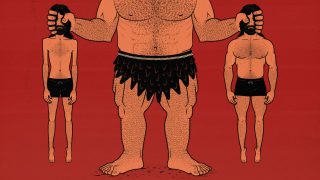
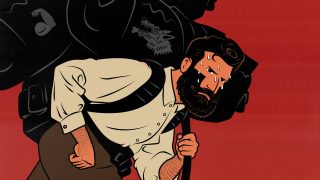
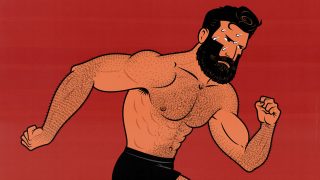
“In this article, we’ll explain why you’re gaining belly fat instead of muscle when you lose weight, and why you’re burning muscle instead of fat when you gain it.”
Feel like you meant to say, “…we’ll explain why you’re gaining belly fat instead of muscle when you GAIN weight, and why you’re burning muscle instead of fat when you LOSE it.”
Yes, yes indeed! Thank you!
(And also, great to hear from you, man!!)
A very awesome articles for skinny guys wanting to gain muscles…. totally Loved it❤
Thank you, Watcher!
Great read. I’m still struggling at 6′ and 170 pounds at 23% body fat with a 33-inch waist. I train 4 days a week with a PPL split and 20 minutes per workout on the bike. My diet is clean. I was told I would have to be 135lbs to have the muscle definition I want. Frightening!
I’m not sure how lean you want to get, but if you want to get to the middle of the healthy range (which tends to be ideal for attractiveness, too), you’d be looking at around 150 pounds at 15% body fat. But that’s not quite right, though. That would be assuming that you won’t build muscle. But you can!
If it were me, I’d do a modest cut until I was at around 18% body fat. You don’t have to, but you might have SLIGHTLY better health markers there. Maybe. To do that, I’d cut slowly, losing maybe 0.5–1 pound per week, trying to gain muscle and strength as I went. I think that’s totally realistic. And then once I got to 18%, I’d try to bulk up pretty leanly. You could focus on building muscle for a while, gaining weight slowly, always trying to gain strength. And then once you accomplish some of your strength goals, you could try cutting down to something like 15%.
The only word of warning is that it can be rather difficult to build muscle at low body-fat percentages. So I wouldn’t cut down super lean and then try to lean bulk. I think it would just be wasting time trying to get lean, you’d look thinner than you want to look, and then the fat would come right back as soon as you try to gain muscle and strength again. You can cut down to and bulk at under 20% body fat, though 🙂
You’ll get there, man. I know it’s a frustrating place to be in. But the good news is that you’re in a great place to lose fat and build muscle. You got this 🙂
Great article!
Thank you, Ashcroft 🙂
Interesting read. Quite informative. Looking forward to follow the BIG 5 and inculcate it in my lifestyle.
Hej Shane, thank you for the inspiration! I feel ready to take action
That’s awesome! Good luck, Michael 😀
Hey Shane, I found the article very interesting. My only question is what type of cardio would be helpful and how often should we do it along with the resistance training?
Interested to hear Shane’s reply as well. I’ve read in many places that long and slow cardio is best for reducing fat levels, as the aerobic energy systems in the body run best on fat as fuel. If you get the cardio intensity too high, like HIIT, you’re into the anaerobic energy system, which runs best on glucose and blood sugar and carbs. So think jogging, rowing, cycling, swimming, anything for distance at low to moderate intensity where you could still carry on a conversation.
That said, others say fat loss is purely a mechanic of calories in versus calories out and you will not burn fat if you’re not in a caloric deficit, no matter what type of cardio you do. So those folks say cardio is not even required. All it’s doing is helping you burn more calories, which you could just as easily do by eating less.
I kind of like the idea, personally, of all three. I think slow and steady cardio has its place for certain heart adaptations, high intensity cardio work like sprints causes different adaptations that are equally desirable, but if the overall goal of the cardio is fat loss, do whatever you enjoy and eat smaller portions. 🙂
Yeah, I agree with all of this. The best way to lose fat is to lose weight. To lose weight, you’ll need to burn more calories than you consume.
Exercise helps determine where that weight loss comes from. If we lift weights, we have a better shot at gaining or maintaining muscle mass while burning more fat. Other types of exercise, such as cardio, seem to help with this as well, albeit to a lesser extent. It’s possible to get great fat loss results simply from eating in a calorie deficit and lifting weights.
When adding in cardio, we’re talking about walking all the way up to sprinting.
On the slow and steady side (LISS), a brisk walk is about the slowest you’d want to go to get cardiovascular benefits. Jogging and biking and rowing can also be great. As JohnnyGoPillaging points out, these lower-intensity forms of cardio allow us to burn fat as fuel.
When we’re doing higher-intensity exercise, such as a series of sprints (HIIT), we aren’t burning fat during the workout, but it stills helps us lose fat. Not only does it burn calories, but it also helps us burn the stubborn visceral fat that people often have trouble burning. (This is true of other forms of exercise as well.)
Which type of cardio should you do? HIIT is efficient but painful, and it has a bit of overlap with lifting weights. LISS is less efficient but also less painful, and it’s quite distinct from lifting weights, which I suspect might give us some additional benefits. Both are fantastic, great for our health, and worthy parts of a fat loss routine.
How often should you do it? That’s really up to you. Maybe you ease into it with a single cardio workout per week. Once that starts to feel easier, try adding a second cardio workout. Doing 1–3 cardio workouts plus 2–3 hypertrophy training workouts per week is amazing.
Great article, appreciate you sharing the studies and explaining the data. I was hooked when I read your thoughts on Cardio. So many “experts” want to say “no cardio is best for weight loss, just lift” but theres no science behind it. Your explanation on calories, exercise considerations and lifestyle enhancments make sense.
Will be reading more from your site! Thanks
Thank you so much, Andrew! 😀
For what its worth Shane, good, valuable information like this makes me much more likely to engage and buy your services (I assume there is something to buy). I know from my own business these types of articles can be time consuming but your willingness to share your knowledge helps me to want more! Thanks again.
Thanks for the great article! Do you have any recommendations for someone with “stubborn” belly fat?
For context, I’m 6’2” and bulked up over the last year from 145 to about 163 when I started lifting. That weight was mostly muscle, but I’ve had a little ring of belly just above my waist for years. After reading this article, I decided to try cutting. I lost 12 lbs and maintained my new muscle (based on appearance and strength). But the belly fat is still there. I already have very skinny wrists and ankles, and I worry that cutting further would make me look even more malnourished and it might even be unhealthy. Should I accept that this just happens to our bodies over time (I’m 30) and focus on building muscle? Or is there something I can do to target that little annoying ring of belly fat?
Congratulations, man! That’s awesome 😀
Stubborn belly fat is burned like the rest of it. You’ve just got to combine a calorie deficit with a good diet, good sleep, and exercise (such as lifting weights, walking, and or/cardio). But really, it’s mostly about getting lean enough—about losing enough weight.
If you haven’t lost your belly fat yet, that’s totally normal. Belly fat is often the last to go. Sounds like you’re doing a great job, so it would just be a matter of keeping it up.
Everyone has different standards, so it’s a bit hard to know exactly what you mean when you say a “ring of belly fat,” but if you’ve got a bunch of belly fat, I doubt losing another dozen pounds would be bad for your health.
On the other hand, you don’t necessarily need to get THAT lean. And if you’re more excited to build muscle than keep losing fat, I’d say start focusing on slowly, leanly gaining muscle and strength 🙂
Thank you for this great info! Really appreciate how everything was kept simple and concise.
My only question –
I’m 5’9″ 155 lbs, in great health, and consider myself lean/fairly toned. However, I am definitely skinny fat. My belly looks as if I eat wings and drink beer all day. I’ve always had some fat there, but it became more noticeable at the end of 2020. (My theory is that I was living a more sedentary lifestyle due to the pandemic by working from home and not going to a gym.)
I think I’ve been in a good routine—applying tips from this article—since the beginning of this year, but I feel a bit discouraged. I am not really seeing a reduction in my belly size. (Maybe a little bit?) My theory is that I am constantly in a calore deficit. My Fitbit says I burn an average of 2,500–2,600 calories per day (taking this with a grain of salt, of course), which could maybe cause my body to hang on to this belly fat as much as possible since technically this could be “starvation mode.” I am definitely not eating 2,500-2,600 calories per day.
Would you agree on this theory or have any other thoughts?
I know you’re probably looking for Shane’s advice on this. I’ll say though, if you’re actually in a calorie deficit, you’ll be losing weight week over week. So if you want to know for sure, weigh in at least once a week, first thing in the morning after using the restroom, and see what your weight is doing. That’s the only reliable thing to inform diet changes. If your weight isn’t changing much, then you’re not really in a deficit.
Thank you, Johnny, and appreciate the quick response. I’ll take any advice as this has been a very frustrating situation – working out, healthy diet/lifestyle, etc. (in my opinion), yet still have this “Kermit the Frog” shape with most of the fat concentrated at the belly and very little fat anywhere else. For some reason, this belly fat has been extremely stubborn for quite some time. This is why I had the “starvation” theory, but I’m actually unsure of my weight fluctuations since I don’t own a scale. I guess that would be the first step.
JohnnyGo is exactly right, yeah. If you’re losing weight, you’re in a deficit. You’ll know how much of a deficit you’re in by how much weight you’re losing. And if you’re in a deficit, you should be losing fat. The other possibility is that you’re losing lean mass, but if you’re lifting weights, eating enough protein, and being active, that shouldn’t be happening. You may even GAIN muscle while losing fat.
If you aren’t noticing visible changes, my guess is that you aren’t actually in a calorie deficit. But, as you said, you can solve that mystery by buying a scale.
Starvation mode isn’t really a thing. When you’re in a deficit, your body needs to get that missing energy from somewhere. You burn fat and/or muscle. Your metabolism will slow when you eat fewer calories, just like it will speed up when you eat more calories, but that’s a normal thing. Even when you’re doing everything right, your metabolism will adapt to your calorie intake.
Genetics plays into this as well. For instance, “hardgainers” have metabolisms that get WAY faster as soon as they eat more calories, making it hard to actually get into a calorie surplus. There’s also something called a “thrifty” metabolism, where your metabolism slows down when you attempt to get into a calorie deficit. The method is still the same, though. You still need to lift, move, eat enough protein, and eat in a calorie deficit.
Finally, you might be making good progress! These changes happen gradually. Maybe you just aren’t noticing the fraction of a pound you’re losing every day. Maybe you aren’t noticing that your waistline has gotten 0.25″ smaller. The only way to know is to measure. Take some photos, too!
I hope that helps, and good luck! You’re already a month in. That’s often the hardest part. Just keep it up a bit longer and try to cement these healthy habits in 🙂
Very helpful and much appreciated – thank you Shane!
I went to Google to find out why I’m skinny fat. I want to know what to do about it. I couldn’t believe I could find it so fast.
As a beginner, the five general keys given are easy to remember. (I like it so much because of that.) It’s not intimidating. It’s very beginner-friendly and not burdensome. I super recommend it! Thanks, Shane and Marco.
Thank you so much, Eric! So stoked to hear you liked it 😀
this article was great…like the others I was googling skinny fat and this was by far the most useful one I found.
I am 65kg (143 lbs) and 175cm (5’9″), no pecs with super skinny arms and I have a belly 😐 . I was told I have 20% body fat by a nutritionist a couple of years ago (it’s prob more now)
Did I understand correctly that I should start with a slight calorie deficit (cutting)?
Also have some lower back problems so have to choose carefully what exercises I do.
Thank you, man! I’m glad you found it helpful.
If you’re already slightly above the healthy body-fat range, I wouldn’t recommend bulking, since it will probably drive your body-fat percentage at least slightly higher.
Instead, I’d recommend a slight calorie deficit if you want to focus on losing fat. Or you could eat according to your appetite (which should put you around maintenance) if you want to focus on getting stronger and trying to achieve a bit of body recomposition. Whichever path you choose, a few months from now, when you stop being able to steadily gain strength on your big lifts most weeks, you can think about increasing your calorie intake. By then you should be lean enough for it.
Lower back problems are definitely a bother. You can start with an easy deadlift variation like a dumbbell sumo deadlifting. That way you’re getting your back used to lifting lighter loads with good technique, and you aren’t really putting that much stress on it. You can progress to harder variations from there, when you’re ready for it. With squats, think of variations like goblet squats that allow you to keep your torso upright, minimizing stress on your lower back, but that still demand SOME strength from it, that way you build it stronger. For most of your other lifts, just choose variations that feel good. Maybe that means push-ups, Larson presses, or machine chest presses instead of barbell bench presses with an arched back. Maybe you’re doing t-bar rows and one-arm dumbbell rows instead of bent-over barbell rows. And, of course, if you’re seeing someone like a sports physiotherapist, then their advice can override mine 🙂
Good luck, man! You got this!
Thank you very much!
What a great article. Explained in simple language. Now I completely understand the do’s and don’ts, as I am skinny fat.
Thank you so much.
My pleasure, Rohit! Good luck!
Very informative article, I workout and I’m very active at work my problem is I just can get rid of my belly fat I weight 145 5’9” so I don’t know if I should up my protein and drop my carbs and do I need to lose more weight or gain weight
Hey Henry, thank you!
It sounds like you’re struggling with belly fat. That’s a fat issue. The best way to lose fat is to get into a calorie deficit. You don’t necessarily need to drop your carbs, but you do need to drop SOMETHING. If you have processed/junk food in your diet, you could try swapping that stuff out for food that’s more filling and more nutritious. For example, you could swap out chips for popcorn, ice cream for Greek yogurt with frozen berries, or pretzels with carrots. That kind of thing.
If you already eat a good diet, you just need to yank some calories out. Maybe that means cutting back on carbs. You could also cut back on fat. Totally up to you. I’d aim to eat a balanced diet, though. Ideally, most of your meals would have a source of protein, some healthy fats, some carbs, plenty of fibre, and loads of micronutrients.
If you wanted to focus on building muscle instead of losing fat, you could try gaining weight. That won’t help you lose your belly, though. Maybe worry about that afterwards. It’s always hard to say without a full “before” assessment. I usually look at some photos, measurements, and get a better idea of someone’s goals before making recommendations.
Good luck, man! Sounds like you’re already off to a good start. Being active is often the hardest part.
Thank you and I will take that it considerations, I do eat healthy but I believe I don’t eat enough that’s my problem but thank you
My pleasure, man. Good luck!
I love article’s like this where the basic advice is to exercise, lift weights and cardio, plus eat better.
WHAT??!! My mind is blown!
We aren’t trying to blow up people’s heads, just their bellies 🙂
Thank you so much for the article and the info. I’m 6’2″. I weighed 150 when I left for college, 165 (very low body fat) when I graduated college, then dropped to 150 again after developing a gluten allergy. I then hit the weights and the protein hard and got up to 190 with low body fat over the course of two years. That was 20 years ago. I’m now at 195 and have lost a lot of my muscle mass over the past 5 years due to a sedentary lifestyle. Over the past two months, I’ve developed a good workout habit and am excited to be lifting weights again and getting back in shape. At age 48, the skinny guy with a gut (and poor heart health, etc) was a nightmare I wasn’t willing to live (or die) with. I’m highly motivated to make this happen. Being in shape feels so much better and my family deserves for me to be healthy. I’ll continue to check out your articles and materials. Thank you again for your story, your research, and your advice.
Thank you so much, Craig. Good luck getting into shape! You got this!
This article is so helpful and I read it few times. I am 5’5 127 pounds and recently started working out and lifting weight.
I am eating more calories and protein to gain more pounds up to 140 and will start on my belly fat. Is that a good approach?
That’s awesome, Bhola! Congratulations on the gains! You’re killing it.
Yep, that approach sounds great. Just take a slow approach to gaining weight. Be patient with it. And then, once you’re happy with how much muscle you’ve built, maybe try slowly losing weight to chisel away the fat.
Keep it up!
Hello Shane, this article and commentary has been very enlightening. I’m often told that know muscle is gained in the gym and fat is lost in the kitchen. I’ve seen the former and been disappointed in the latter. My nutrition is often the hardest to modify. I try to get “enough” protein w/o over-eating. I also struggle with trying to have a caloric deficit, yet keep myself fueled enough to lift heavy, or go for a ride.
I’ve read to only eat carbs on your workout days, but what if you’re working out some each day (cardio vs weights)?
Any insight into when to consume protein vs carbs would be very useful!
Thank you, man!
You lose weight by getting into a calorie deficit. You can create that deficit in the kitchen (by eating fewer calories) or in the gym (by burning more calories). Once you create that calorie deficit, your body can then decide whether it will burn muscle, fat, or a mix of both. Your diet can impact whether you lose muscle or fat. So can the gym. So it’s really both the kitchen and the gym that will help you lose fat.
I hear ya, man. It’s hard to eat enough protein while eating fewer calories. And when you’re in a deficit, you won’t feel as strong or energetic. Your body is lacking energy. Makes sense that you’d feel a lack of energy.
(People usually feel a surge of energy from producing more cortisol. The “go hunt and gather!” response to undereating. But then if you continue undereating, your body tries to burn fewer calories to cancel out the deficit. When that happens, you’ll have less energy. It’s not a “bad” thing, it’s just that your body is trying to resist starvation whereas you’re trying to burn fat. It’s a mismatch of goals.)
I would think that you could eat carbs on any day. I’m not sure why you were told to only eat carbs on workout days. I could be missing some context. You may enjoy having some carbs before your workouts, though. That might give you a bit more energy.
A balanced meal has a source of protein, some healthy fats, some carbs, a hearty amount of fibre, and plenty of micronutrients. I would try to eat balanced meals whenever you can. That tends to be the healthiest way to eat, and it’s fantastic for building a strong, lean body.
I hope that helps! You got this, man. Good luck!
Brilliant article, thanks for sharing.
I feel like I have reached a plateau. I’m actually doing all 5 interventions (learned over time through various sources) but I can’t reduce my belly fat.
I’m 40, M, 5”10. Skinny fat all my adult life. Last year I decided to make a change. I cut out all processed food and fizzy drinks. I started going to to gym to lift and achieved some really good gains. I had never been to the gym before this.
For the past 4 months I’ve been focusing on nutrition along with the gym routine and I’m counting everything. I managed to keep a 500 calorie deficit with a protein intake of 130-150g per day for the past 3 months (2 scoops of whey really helps). I’ll maybe have a cheat day with pizza but I’ll never go above 2500 calories that day. And the cheat day is only once a week 🙂
I hit the gym three times a week. I’ll do dumbbell press, Romanian dead lifts (alt goblet squats) , dumbbell rows and increase the weight progressively.
I go to bed early and get a good 8 hours sleep too on week days. But after all this, I still can’t make any impact on my belly fat. I’m also not making any more gains on my muscles like I was before. Another strange thing is that my weight is a constant 70kg since I started focusing on nutrition. I might get one or two kg lighter but it’s always 70kg most days.
Sorry for the long comment but it’s just really frustrating.
Do you have any suggestions on what I should change? Or should I keep going with my plan
Hey Mando, what you’re doing sounds great. That must be frustrating, doing all of that and STILL not getting the results you want.
The issue is the calorie deficit. A calorie deficit is defined by eating fewer calories than you’re burning, forcing your body to get those missing calories from stored energy (such as fat or muscle). If you aren’t losing weight, then you aren’t burning any stored energy, and so you aren’t actually in a calorie deficit. You’ve got to drop your calorie intake a bit lower.
Weigh yourself every week. If you aren’t losing weight, drop your calorie intake a bit lower.
Keep lifting, being active, eating well, and getting good rest. You’re already doing all of the hardest things, and I suspect they’re already working wonders on your health 🙂
Hey! Great content man, all I’ve ever needed.
Just a question. I’m 5’10 and I’ve been lifting for 6 weeks now. I’ve managed to go from 64kgs to 70kgs (141 pounds to 154 pounds) in around month and half. I’ve noticed I am a little bigger but a lot of fat on my belly too (skinny fat build) and it keeps building.
I’m tracking calories and consuming around 2,200 everyday (sedentary lifestyle + walks with dog + 3x week gym). My diet consists of 46% of fats. 32% of carbs and 21% of protein. I’m thinking I need to swap some fats (peanut butter, milk , less olive oil) to carbs. Any tips on that? I am still gaining muscle I think as I am getting stronger, but gaining a lot of fat too.
I don’t know where to go now. I don’t care much about belly fat now (I want to chisel it away later). I’m thinking of bulking further to around 175 pounds, and then cut. Or perhaps do recomp now? My arms are still small and I care about aesthethics. Any tips?
Congrats on getting to your 6th week, man! And congrats on those 6 kilos! That’s great!
You’re gaining weight very quickly. It’s too many extra calories, so your body is storing the extra as fat. You need to trim back on the calories, settling into a slower rate of weight gain.
If you have a tendency to gain fat, a lean bulk will probably work well for you. I recommend trying to gain 0.5 pounds per week. If you gain faster than that, eat a little bit less. You could start by eating 300 fewer calories per day. See how that goes and adjust as needed.
Swapping fats to carbs is great, but your main issue right now is calories. Your sources of fat are healthy. Peanut butter, milk, and olive oil are great. I wouldn’t worry too much about that. But you need fewer calories anyway, so maybe switch to a low-fat milk. You might even be able to find a high-protein, low-fat milk.
The good news is that you’re probably gaining muscle very well. We just need to cut back on the fat gains.
You don’t need to stress about the belly fat, but I wouldn’t gain it on purpose. The leaner you can keep your gains, the longer you can bulk, and the less time you’ll need to spend cutting. When you notice you’re gaining fat, slow it down.
154 at 5’10 isn’t too heavy. 175 sounds like a good goal, especially if the fat isn’t bothering you. I think you can go deeper into your bulk. Just do it slowly and really focus on gaining strength.
Those 20 pounds might take you a year if you bulk slow and steady. If you get sick of bulking, you can take a break to cut off the fat. Maybe do another 5 months of bulking, aiming for another 10 pounds. Then do a cut down to a comfortable body fat percentage (maybe 12–15%). Then you can start bulking again, if you want.
You got this 🙂
omg, if only articles on internet were this much professional, useful and ON POINT.
as a skinny fat guy, you i can say you answered all my questions.
thank you so much for making this valuable article FREE. thanks for not trying to sell/push your products down our throat after each sentence,as it’s done in other web articles.
A summary of researchs, your expertise, facts.